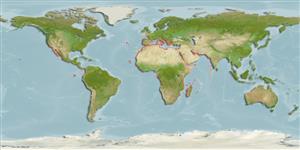Common names from other countries
Environment: milieu / climate zone / depth range / distribution range
экология
; солоноватоводный; пределы глубины 0 - 2 m (Ref. 80843). Tropical, preferred 23°C (Ref. 107945); 52°N - 35°S, 123°W - 75°E
Circumglobal.
Length at first maturity / Size / Вес / Возраст
Maturity: Lm ? range ? - ? cm Max length : 1.5 cm TL самец/пол неопределен; (Ref. 101378)
Inhabits extreme environments such as salt lakes or brine waters, coastal or inland (Ref. 105262), just like saline lakes, and coastal salterns (Ref. 105501). Its nauplii is an irreplaceable live feed for marine and shrimp larvae. Latent eggs cysts are known to withstand long drought periods at severe hypersalinity (Ref. 105261). In an experiment, adults are fed with the dinoflagellate Gyrodinium corsicum and Cryptophyta Rhodomonas baltica (Ref. 105262).
Life cycle and mating behavior
половая зрелость | размножение | нерест | икра | Fecundity | личинки
Reproduction mode may be oviparous or oviviparous, depending on environmental conditions. Copulation is present. Life cycle: Eggs may either develop into nauplia (larvae) or may stay as cysts (dormant) to survive the drought period before hatching into nauplia.
Основная ссылка
ссылки | координатор | соавторы
Bisby, F.A., M.A. Ruggiero, K.L. Wilson, M. Cachuela-Palacio, S.W. Kimani, Y.R. Roskov, A. Soulier-Perkins and J. van Hertum. 2005. (Ref. 19)
Статус Красного Списка МСОП (Ref. 130435)
Статус СИТЕС (Ref. 108899)
Not Evaluated
Not Evaluated
Использование человеком
рыболовство: коммерческий; аквакультура (рыбоводство): коммерческий
FAO - аквакультура (рыбоводство): production; рыболовство: landings | FishSource | Sea Around Us
инструменты
дополнительная информация
Возраст/РазмерыростЗависимость между длиной и массой телаЗависимость между длинамиморфологияличинкичисленность
ресурсы в Интернет
Estimates based on models
Категория цены
Unknown.
